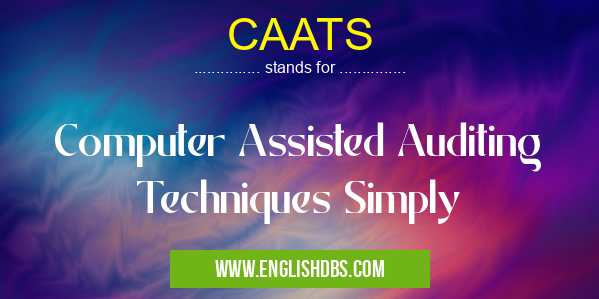What does CAATS mean in AUDITING
CAATS stands for Computer Assisted Auditing Techniques, referring to the use of specialized software and technologies to enhance and support the auditing process. CAATS enables auditors to perform tasks more efficiently, effectively, and comprehensively, resulting in improved audit quality and timeliness.

CAATS meaning in Auditing in Business
CAATS mostly used in an acronym Auditing in Category Business that means Computer Assisted Auditing Techniques Simply
Shorthand: CAATS,
Full Form: Computer Assisted Auditing Techniques Simply
For more information of "Computer Assisted Auditing Techniques Simply", see the section below.
Key Features of CAATS
- Data Extraction and Analysis: CAATS tools can extract data from various sources, such as accounting systems, databases, and spreadsheets, allowing auditors to analyze large datasets and identify patterns and anomalies.
- Testing Automation: CAATS can automate repetitive audit procedures, such as analytical reviews and control testing, freeing up auditors for more complex and analytical tasks.
- Risk Assessment: CAATS can leverage data analytics to identify areas of higher risk, enabling auditors to focus their efforts and prioritize resources.
- Reporting and Visualization: CAATS tools facilitate the generation of comprehensive audit reports and visualizations, enhancing communication and understanding of audit findings.
Benefits of Using CAATS
- Increased Efficiency: Automation and data analysis capabilities streamline audit processes, reducing time spent on manual tasks.
- Improved Audit Quality: CAATS enables auditors to cover a wider scope of data and perform more in-depth analysis, resulting in enhanced accuracy and reliability of audit results.
- Time Savings: The efficient use of CAATS can significantly reduce audit time frames, allowing auditors to deliver insights and recommendations more promptly.
- Enhanced Risk Management: By identifying high-risk areas through data analysis, CAATS supports proactive risk management strategies.
- Improved Collaboration: CAATS facilitates collaboration among audit teams and with clients, fostering seamless communication and efficient knowledge sharing.
Essential Questions and Answers on Computer Assisted Auditing Techniques Simply in "BUSINESS»AUDITING"
What are Computer Assisted Auditing Techniques (CAATs)?
CAATs are advanced data analysis tools and techniques used by auditors to enhance the efficiency and effectiveness of audit procedures. They enable auditors to extract, analyze, and interpret large volumes of data from various sources, including accounting systems, databases, and spreadsheets.
What are the benefits of using CAATs?
CAATs offer numerous benefits, including:
- Improved efficiency and time savings
- Increased accuracy and reliability
- Enhanced risk assessment and fraud detection
- Improved documentation and audit trail
- Better communication and presentation of findings
What types of CAATs are commonly used?
Common types of CAATs include:
- Data extraction and analysis tools
- Statistical sampling and analysis tools
- Data visualization tools
- Risk assessment and fraud detection tools
- Audit trail and documentation tools
- Continuous monitoring and assurance tools
Who uses CAATs?
Auditors of various backgrounds and experience levels use CAATs. They are particularly beneficial for:
- External auditors
- Internal auditors
- Government auditors
- Forensic accountants
What are the limitations of CAATs?
While CAATs provide significant benefits, they have certain limitations:
- Can be costly to implement and maintain
- Require specialized knowledge and skills
- May not be suitable for all audit procedures
- May produce false positives or negatives
How can I learn more about CAATs?
Several resources are available for learning about CAATs:
- Professional organizations (e.g., AICPA, IIA)
- Training programs and workshops
- Online courses and certifications
- Industry publications and conferences
Final Words: CAATS is an essential tool in modern auditing, providing auditors with the capabilities to perform audits more effectively, efficiently, and comprehensively. By leveraging data analytics, automation, and visualization, CAATS empowers auditors to enhance audit quality, meet regulatory requirements, and deliver valuable insights that contribute to organizational success.
